“Love doesn't make the world go 'round. Love is what makes the ride worthwhile.” -Franklin P. Jones
It's been such a busy time here at Starts With A Bang that we're a day late bringing you last week's recap! And we've got to get rocking on it, because there's so much coming up to consider as well! First off, the Patreon campaign is even closer to our next goal, with a total of 128 active patrons. We did a Podcast for Science By Number talking about dark matter/dark energy and inflation and expansion:
- How many atoms do you share with King Tut? (for Ask Ethan),
- What was the biggest storm in our Solar System's history? (for Mostly Mute Monday),
- How to hold a dead star in your hand (by X-ray scientist Kim Kowal Arcand),
- The biggest hopes of what a new particle at the LHC might reveal,
- How would our Universe be different without dark energy?, and
- When did Isaac Newton finally fail?
It's almost time for Memorial Day weekend, which means it's almost time for the four-day extravaganza that is Balticon 50! I'll be talking about gravitational waves, pseudoscience, the fate of the Universe and a whole lot more, including recording a live podcast on traveling to the stars. (And selling and autographing books, too!) There's probably no Comments Of The Week for next week due to the travel, but we'll still have a busy week full of wonderful science, so let's dive into what you gave us to consider!
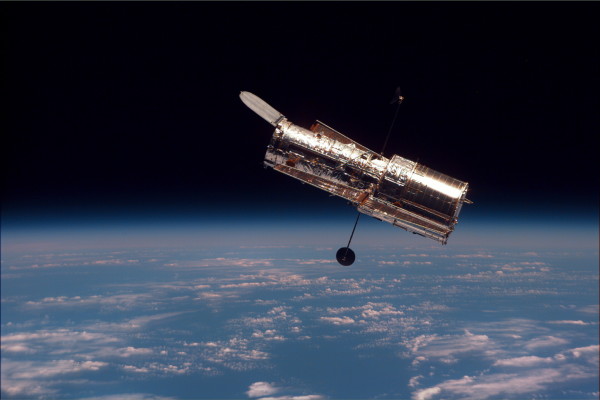 The Hubble Space Telescope, as imaged during the last and final servicing mission. Image credit: NASA.
The Hubble Space Telescope, as imaged during the last and final servicing mission. Image credit: NASA.
From eric on an oxygen-rich exoplanet: "In order for a reasonably similar atmosphere you have to assume oxygen-using organisms don’t co-evolve over the first billion years, allowing the [anarobic] life to change the atmosphere and make it unlivable for themselves in the process…and then aerobic oxygen-using organisms must evolve, along with carbonate-using aerobic organisms, and that all these organisms reach the same equilibrium point."
The big issue here isn't whether oxygen is required for complex life (it probably isn't), but rather in what percentage of cases will life wind up producing a substantial amount of oxygen? If we found an Earth-like planet (rocky, ~Earth sized, in a star's habitable zone) with even 0.5% of the atmospheric content as molecular oxygen, it'd be quite a stretch to produce that much without having an organic process behind it. The sign isn't necessarily a similar atmosphere; it's an atmosphere with any appreciable amount of oxygen in it at all. The first time we find one, it's going to be an awfully suggestive hint of life. Other explanations will exist, but that's as close to a "smoking gun" signature as we could ask for.
From Ragtag Media on... capitalism, I guess: "Ethan sells his product on the free marketplace of ideas and all parties benefit."
You heard it here first, folks, although nothing is final: there's a very good chance that my second book will be... on the science of the various technologies in the Star Trek Universe, including the holodeck! Bringing a fictional Universe and our real, physical Universe together is maybe one of the best ways to get people interested and involved in the real science -- and its excitement -- that we have going on today.
 Image credit: Rutgers, retrieved from http://www.physics.rutgers.edu/~zrwan/physics/.
Image credit: Rutgers, retrieved from http://www.physics.rutgers.edu/~zrwan/physics/.
From Michael Kelsey on the Stern-Gerlach experiment: "The important thing for you to take away here, is that the measurement is a vector, not a scalar. In addition to the +1/2 or -1/2 value, you *MUST* include the direction (axis) of the measurement."
This is absolutely right, and it brings up an important case that I didn't bring up when I talked about successive measurements. Let's say you measure the spin of an electron in the x-direction for the first time: you'll have a 50/50 shot of +1/2 and -1/2 in the x-direction. Now let's say you measure again, either in the x-direction or y-direction. If you measure again in the x-direction, you'll get, with 100% certainty, whatever you measured the first time. If you measure again in the y-direction, you're back to 50/50: +1/2 or -1/2 in the y-direction, and if you make that measurement in the y-direction, you destroy the information about the x-direction.
But what if you were to make that first measurement, and then make a second measurement that was partially in the x-direction?
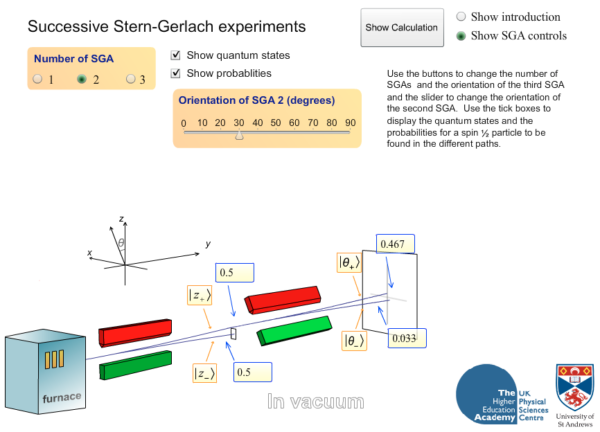 Screenshot from the University of St. Andrews, of two successive Stern-Gerlach experiments. Image credit: http://www.st-andrews.ac.uk/physics/quvis/simulations_phys/ph42_Stern_G….
Screenshot from the University of St. Andrews, of two successive Stern-Gerlach experiments. Image credit: http://www.st-andrews.ac.uk/physics/quvis/simulations_phys/ph42_Stern_G….
You'd have a probability distribution that was a linear combination of the known (100%/0%) states and the indeterminate (50%/50%) states. It's a remarkable illustration of the simultaneous vector nature of inherent angular momentum and of quantum indeterminacy. It's a tough concept to wrap your head around, but it's also a fun and fantastic truth about our inherently quantum Universe.
Tony Mintz eating a banana, from his YouTube channel at https://www.youtube.com/watch?v=1AOPlkM77qA.
From Naked Bunny with a Whip: "Pfft. I craft-brew my own atoms from scratch. /smug"
If you really want to enhance your atom-brewing abilities, eat a banana. Much of what we ingest is naturally radioactive, transmuting elements from one type to another through natural nuclear decays. In fact, cosmic rays can occasionally spallate your elements: blasting them apart into smaller constituents. But this natural radioactivity isn't really from scratch. For that, you'd need to make your own matter via E = mc^2. And if you're doing that... well, that's something I'd like to see the brewery process of!
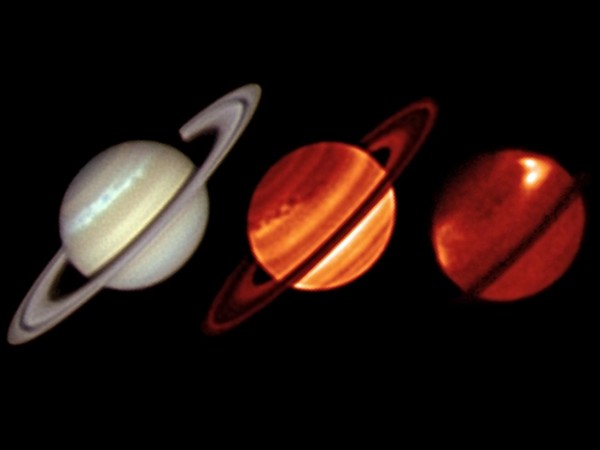 Image credit: ESO/Univ. of Oxford/T. Barry, of Saturn’s 2011 storm in visible and various infrared wavelengths.
Image credit: ESO/Univ. of Oxford/T. Barry, of Saturn’s 2011 storm in visible and various infrared wavelengths.
From PJ on Saturn's massive storm: "Pshawww ….. discussion was on the biggest storm in the solar system. Back to reality."
One fun alternative to consider, although it wasn't really a storm, was how big the disturbance was in the atmosphere thanks to Jupiter's getting struck by Shoemaker-Levy 9.
 The 1.7 and 2.3 micron methane absorption bands using the MAGIC infrared camera at the German-Spanish observatory on Calar Alto.
The 1.7 and 2.3 micron methane absorption bands using the MAGIC infrared camera at the German-Spanish observatory on Calar Alto.
It wasn't a storm, per se, but it was nearly the same size -- in terms of an atmospheric disturbance -- to the size of Saturn's 2011 storm. (It was somewhat shorter in duration, though.) Shoemaker-Levy 9 was a typical-sized comet, though: about 5 km across before breakup. It makes you wonder about larger impacts in our Solar System's history, and what "storms" they might have triggered. It's conceivable that a planet-wide storm has taken place on Jupiter in the past, and that would be the largest one (unless you count the Sun) of all!
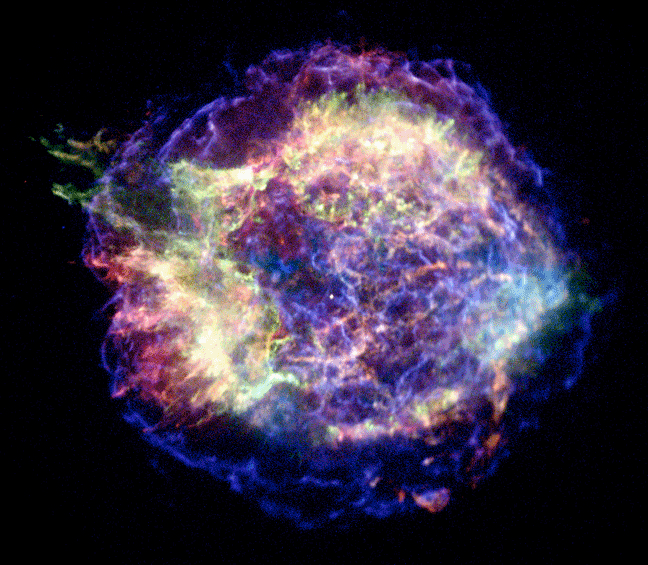 Comparison of the 2006 and 2013 composite images of the Cassiopeia A supernova remnant taken with the Chandra X-ray Observatory. Image credit: NASA/CXC/SAO.
Comparison of the 2006 and 2013 composite images of the Cassiopeia A supernova remnant taken with the Chandra X-ray Observatory. Image credit: NASA/CXC/SAO.
From Denier on the supernova remnant in Cas A: "In theory we know where the elements reside in the pre-exploded star, so a 3D model of their current locations and velocity should allow the event modeling from pre-explosion all the way through to now."
This is not as true as we want it to be! You've no doubt seen the countless illustrations -- including many posted by me, here -- of stars like an "onion" with elements completely segregated by layers.
This is true... kind of. It's true if you ignore things like:
- convection, which may be largely ignorable in these short-lived stars,
- dredge-ups, which can't be ignored,
- elements created in the s-process, which are somewhat important,
- and the chaotic pulsing during a supernova, which is the most intriguing factor.
Yes, the r-process can build up elements very quickly, but the pulsing is interesting because it imparts initial outward momentum differently to the different elements/layers, and then the "crash" into the interstellar medium slows down different elements at different rates. The physics is not yet well-enough understood to do what Denier wants, but yes, we can (and do!) use this information to help better understand the physics of Type II supernova explosions. The biggest uncertainties are about the early pre-supernova phases and the momentum-imparting explosion to the inner-and-outer layers. That's where the biggest knowledge jumps are coming from data like this!
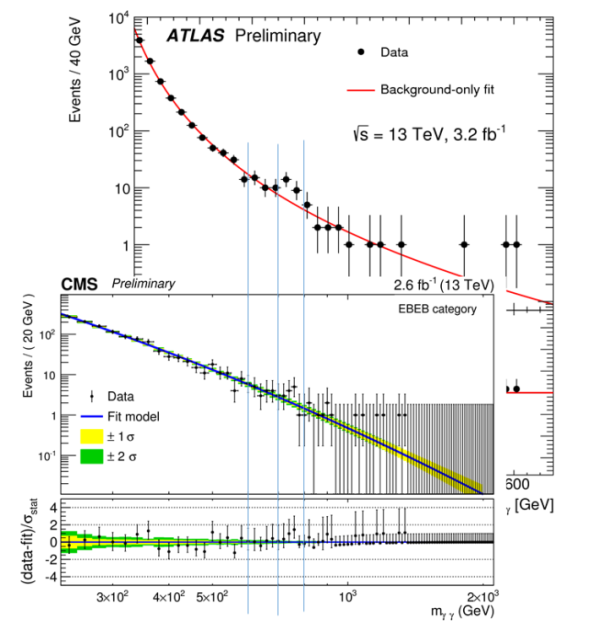 The ATLAS and CMS diphoton bumps, displayed together, clearly correlating at ~750 GeV. Image credit: CERN, CMS/ATLAS collaborations, image generated by Matt Strassler at https://profmattstrassler.com/2015/12/16/is-this-the-beginning-of-the-e….
The ATLAS and CMS diphoton bumps, displayed together, clearly correlating at ~750 GeV. Image credit: CERN, CMS/ATLAS collaborations, image generated by Matt Strassler at https://profmattstrassler.com/2015/12/16/is-this-the-beginning-of-the-e….
From Michael Kelsey on the diphoton bump at 750 GeV at CERN: "Particle physics detectors can only record information about stable or nearly stable particles (those with lifetimes long enough to travel tens or hundreds of meters).
We distinguish charged from neutral particles because the charged ones can leave a trail of ionization through a solid state (e.g., CCD) or gaseous detector (e.g., a drift chamber). Putting those into a magnetic field caused them to follow curved (helical) paths, and we can measure the radius of curvature to get the momentum.
Both charged and neutral particles can deposit energy in calorimeters, where we measure both the amount of energy, and the location where it was deposited. Combining all of this information and more, we get a list of the stable particles in each event, with their mass, momentum vector, and energy.
We identify short-lived particles which decayed by picking out their decay products from that list, summing up their momentum-energy, and getting the mass and charge of the particle which decayed. Of course, we don’t know which combination is right a priori, so we have to make “all” combinations and look for a statistical excess at the mass of some short lived particle.
This is what the “diphoton bump” is. If you take the LHC data, and in each event look for two high energy photons (above 300 GeV each), then calculate the sum of their momentum-energy, you can make a plot of the mass from all of the pairs (diphotons) you picked."
This is a lot of great information (and is Michael's specialty), and the simplest version is that we build these ginormous detectors to measure everything that comes out of a hugely energetic particle collision. Most of the stuff continues in the direction of either one of the beams (the radial direction) so you look for stuff that's evidence of a high-energy collision and the production of new particles or decay products: transverse momentum. That's the stuff that goes "out" in the detector, rather than straight across.
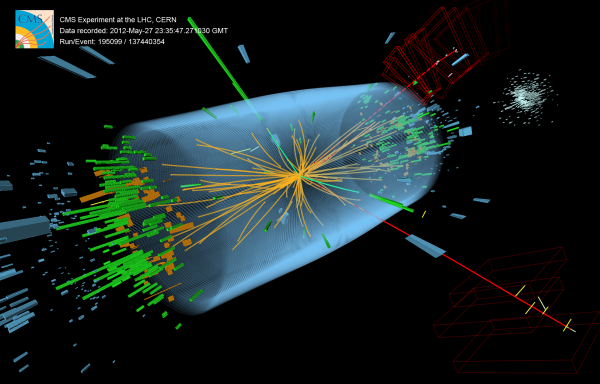 Image credit: CERN / CMS collaboration, of a Higgs event. The transverse direction is "out" of the sides of the cylinder.
Image credit: CERN / CMS collaboration, of a Higgs event. The transverse direction is "out" of the sides of the cylinder.
"Diphoton" just means we look for two photons coming out as part of the decay products, with large transverse momentum. The smooth curve is from the Standard Model (with the Higgs) predictions, while that little "excess" that 750 GeV suggestive "bump" of something new. That's the first hint we have, and we'll find out soon enough whether it's real or whether it's nothing.
Without dark energy, we’d be somewhere in between a decelerating and a coasting Universe. Image credit: NASA & ESA, of possible models of the expanding Universe.
From Michael Kelsey on the age/size/expansion of the Universe, with and without dark energy: "Ethan, if our Universe did not have dark energy, the expansion history would be different, as you’ve noted.
But doesn’t that mean that it’s _age_ would be different as well? In particular, wouldn’t it have a younger estimated age because the expansion needed to get to its current size and rate, was more rapid?"
When you look at a graph like the one above, there's an inherent assumption that's been made: the Universe has the expansion rate (the Hubble constant) it's observed to have today based on the evolution of the Universe to this point. If you want to know how the Universe would be different if it had different energy components, which things would you force to be the same, and which ones would you allow to be different?
- The Universe's expansion rate today.
- The Universe's age.
- The amount of matter present with in it.
- The density of matter present within it.
- The initial energy conditions of the Universe at the moment of the Big Bang.
For those five things I listed, you can only pick one or two at most if you're looking at a Universe with vs. without dark energy.
I chose to have a Universe that was of the same age and had the same total amount of matter to consider; the standard choice (which makes a lot less sense, if you ask me) is to keep the expansion rate today the same. The numbers I got are all based on those assumptions, and is why I wound up with a Universe that was cooler, larger, less dense and expanding more slowly today than the dark energy Universe. Different assumptions would have led to very different Universes today, but we all have to make our choices.
And finally, as a reminder to people like Kurt M., who complain "I can’t use Forbes because of their Adblock policy. That’s too bad."
Yes, that is too bad. It's too bad for your reading experience and for my revenue experience. But you can hang out here, you can go over to Medium and catch articles on a 1-week delay, or you could whitelist Forbes from your adblocker, then turn it back off. Or you could contact Lewis DVorkin and complain to him, since he's the public face of this current Forbes policy.
But I'll keep bringing you stories of the Universe, and you can choose whether to partake or not. In any case, keep enjoying all it has to offer!


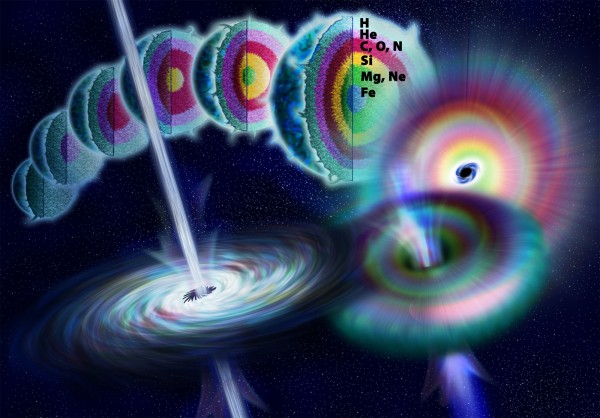
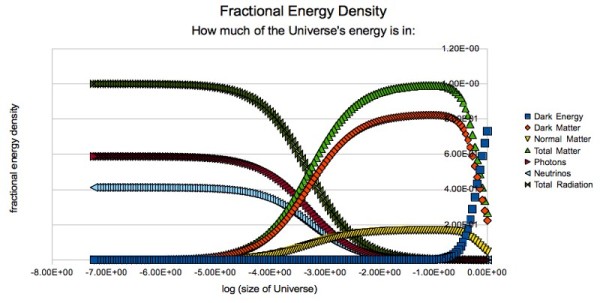

Oh I agree oxygen is a promising sign of life. My point was that there is no reason to expect the majority of life on other planets would produce that end result - because (according to Gould), not even Earth would have necessarily produced that result consistently. IOW, your detection strategy may have a lot of false negatives.
As I've noted before, their (presumably) jquery detector isn't up to the job: turning off Ghostery has no effect.
@Narad #2
I don't use Ghostery so I can't test. I use Chrome with Adblock Plus and an extension called Forbes Splash Screen Bypass. I DO NOT have Forbes white-listed and the page comes up with no advertisements. Sometime I will get caught by the welcome screen, but after the count down I click proceed and it goes straight to the article.
The Forbes system works on tracker cookies which may be why Ghostery is giving you problems. The Forbes Splash Screen Bypass plug-in edits the tracker cookie to make you look like a returning visitor who has already passed the check. It does not block the cookie. Adblock Plus then takes care of everything else. No ads. No downloads from advertisers. No malware.
If you have a javascript blocker, it needs to allow http://rt.liftdna.com/forbes_welcome.js
The cookies I see coming from the site are from forbes.com, cloudfront.net, edge.simplereach.com, and loadus.exator.com. I don't know which is responsible for the blocking or getting through the welcome splash screen. You may need to allow them all.
Good luck.
@Ethan: Thank you for the clarification! It makes sense to me why H0 is usually taken as one of the constraints, since that's an observable. The age is something we have to infer from H0 plus the expansion history (or composition).
I Cant believe how many RETARDED DEMOCRATS complain about the Forbes site TO THIS DAY.
How The HELL are you people even on a science blog (OR ON THE INTERNET FOR THAT MATTER) if a little 5-10 second advertisement disrupts your whole reading?
I simply click the link wait a few seconds read the ad and on to the article.
WHY DO YOU RETARDED IDIOTS FIND IT SO DIFFICULT?
PLEASE TELL ME....
What does complaining about Forbes have to do with political affiliation?
AFAIK the people complaining about it are doing so because (a) Forbes makes then turn off adblocker protection, and then (b) has, in the past, infected computers through malware contained in ads. I'd think people from all political backgrounds could agree that that's a really terrible combination, and doesn't even meet the standards of decent internet housekeeping you'd find on regular sites. Heck even clickbait sites do better than that. Forbes needs to seriously up its game - either do a better job of preventing malware ads from using its site, or allow viewers to keep their adblockers in place. Now in Ethan's defense, he has given his readers a very reasonable workarounds: read the article a few days later on a different site. So I don't see much good reason for the continued complaints.
In any event, your ability to go from "Forbes complaint" to "Democrats are idiots" IMO shows much more about your own character than it does the character of the folks complaining about Forbes.
"WHY DO YOU RETARDED IDIOTS FIND IT SO DIFFICULT?"
What about "voding with your dollar" and "agreeing a price" is opaque to you knucle-dragging idiot teabaggers?
Forbes wants control of our computer, but don't want to be responsible for what they cause to happen to it. We don't want to cede control of OUR PROPERTY, so we shitcan the advertising access.
Forbes is entirely allowed to block people as their response to the negotiation, and everyone else is entirely allowed to find ways around it as THEIR response to that response.
And everyone is allowed to complain about it, since merely voting with your dollars produces NO CUSTOMER SIGNAL, and without a signal from the customer, the supplier has no idea how the negotiations are going.
Quite why this essential and palpably capitalist situation is beyond your comprehension when you profess to know and support the capitalist system that requires this interplay is entirely opaque to the sane proportion of humanity.
"So I don’t see much good reason for the continued complaints."
If you don't complain, how will things change for the better?
Simple as that.
Eric, think of it this way, if there were no complaints Ethan may be hearing only that it's doing well and that it's a waste of effort going for non-Forbes paywall access, and cut out that effort.
It IS effort, and if it isn't known to be needed, entirely rational to stop expending it.
Complaining about it shows that there's still a value to others for the work done.
RM apparently spends his time fantasizing about hitting liberals simply for being liberals, so I'm not surprised that those who anger him are conversely boxed into the "liberal" camp.